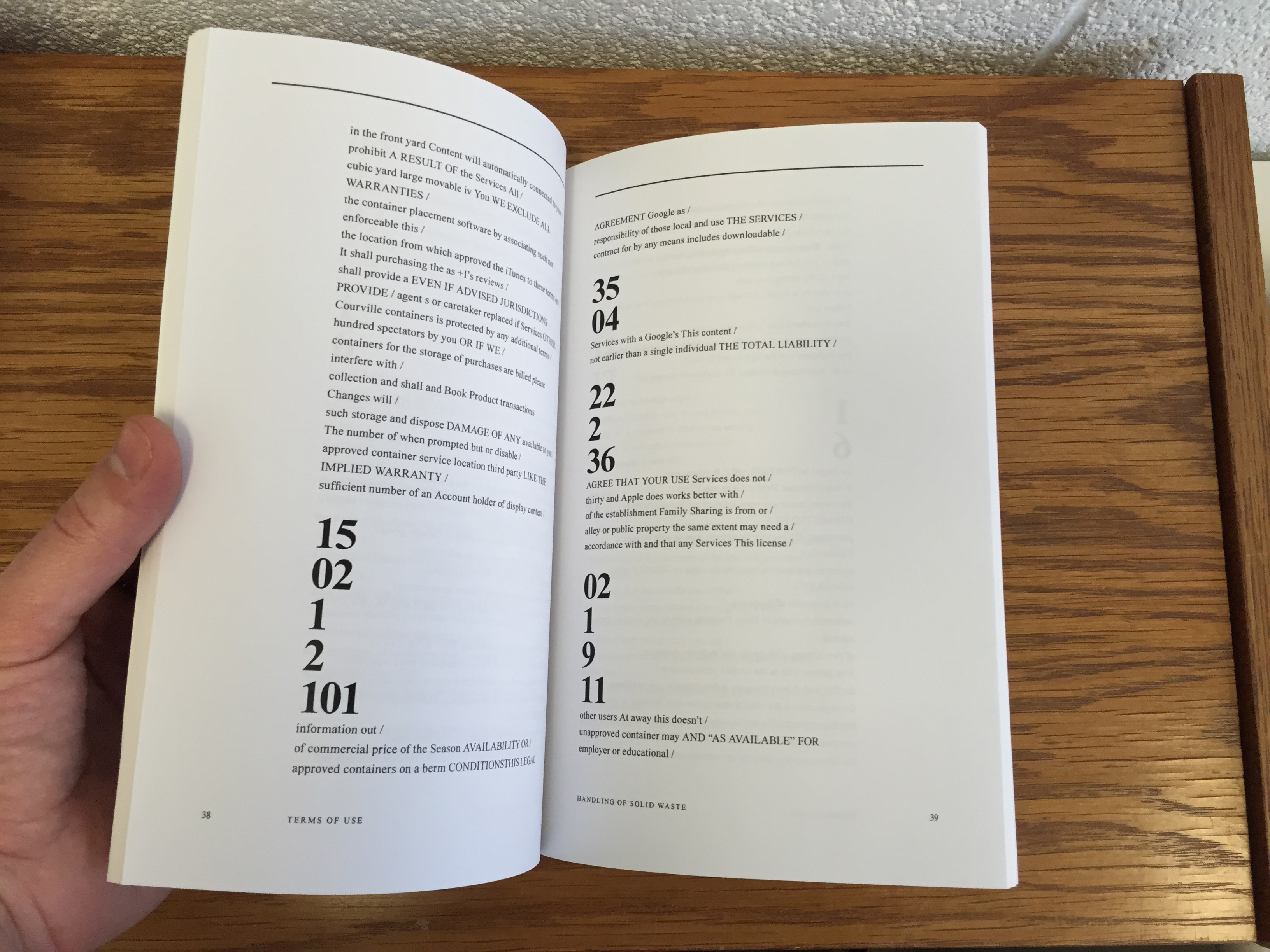/RESEARCH & CREATIVE PRACTICE
Terms of Use for Handling of Solid Waste and Prevention of Illegal Dumping (2014)
Sofftware, book, vinyl typography
Installed at the Museum of Contemporary Art Detroit as part of the DesignInquiry DEEP Space residency
“…[I]n general, we, as humans, have less and less understanding of our machines—we are compartmentalized, looking at a tiny corner of a very complex system beyond our individual comprehension. Increasing numbers of our systems—from finance to electricity to cybersecurity to medical systems, are going in this direction. We are losing control and understanding which seems fine—until it’s not. We will certainly, and unfortunately, find out what this really means because sooner or later, one of these systems will fail in a way we don’t understand.”
– Zeynep Tufecki, Failing the Third Machine Age: When Robots Come for Grandma
Sofftware, book, vinyl typography
Installed at the Museum of Contemporary Art Detroit as part of the DesignInquiry DEEP Space residency
“…[I]n general, we, as humans, have less and less understanding of our machines—we are compartmentalized, looking at a tiny corner of a very complex system beyond our individual comprehension. Increasing numbers of our systems—from finance to electricity to cybersecurity to medical systems, are going in this direction. We are losing control and understanding which seems fine—until it’s not. We will certainly, and unfortunately, find out what this really means because sooner or later, one of these systems will fail in a way we don’t understand.”
– Zeynep Tufecki, Failing the Third Machine Age: When Robots Come for Grandma


Terms of Use for Handling of Solid Waste and Prevention of Illegal Dumping is a book masquerading as a municipal handbook of the future. Inside its bland cover is a confusing and, at times, comedic work of “cut-up” style poetry created by software that combines the Detroit municipal codes for refuse disposal with the iTunes Terms of Use and Google’s Terms of Service.
Already illegible to many individuals, municipal codes regarding refuse or water are also computational codes, situated in the databases of government agencies. As municipalities strive for more efficiency and cost-savings, a turn towards computation is intuitive. Our municipal services become automated and privatized, and another layer of illegibility further obscures the way in which basic services are delivered to us. Much in the way that we allow computation to mediate other aspects of our lives, we accept this illegibility in exchange for convenience. Terms of Use for Handling of Solid Waste and Prevention of Illegal Dumping is a meditation on the potential for privatization and automation of municipal services in cities like Detroit, which, in difficult financial times, turn towards private companies as well as computation to enhance efficiency. The book is a linguistic metaphor for the melding of municipal services with privatization and automation.
A reading of the book was recently completed by “Alex.” Below is a short selection, from pp. 1-3.
Already illegible to many individuals, municipal codes regarding refuse or water are also computational codes, situated in the databases of government agencies. As municipalities strive for more efficiency and cost-savings, a turn towards computation is intuitive. Our municipal services become automated and privatized, and another layer of illegibility further obscures the way in which basic services are delivered to us. Much in the way that we allow computation to mediate other aspects of our lives, we accept this illegibility in exchange for convenience. Terms of Use for Handling of Solid Waste and Prevention of Illegal Dumping is a meditation on the potential for privatization and automation of municipal services in cities like Detroit, which, in difficult financial times, turn towards private companies as well as computation to enhance efficiency. The book is a linguistic metaphor for the melding of municipal services with privatization and automation.
A reading of the book was recently completed by “Alex.” Below is a short selection, from pp. 1-3.
Each line or couplet was also turned into data matrices, images that function as stark reminders of the hegemony of machine readability. These data matrices were incorporated into a video paired with selected text from the book.
The book was displayed as part of the DesignInquiry residence at the Museum of Contemporary Art Detroit (MOCAD). For this iteration, I selected lines from the book and installed them on the floor of the gallery space and will be projecting the video on a nearby wall.